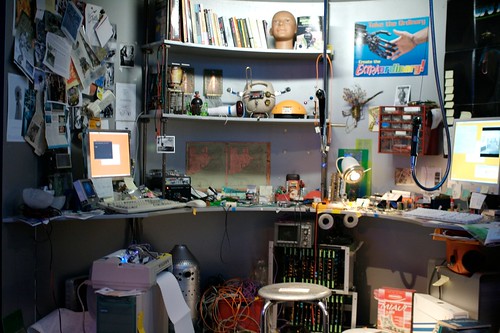POPSCI has an article about the "history of the teardown" and what happens on websites such as ifixit.com/.
 (A robot tinkerer's desk at the design museum in Zürich)
(A robot tinkerer's desk at the design museum in Zürich)
The article describes the important of this kind of activity to understand how things work, child-like memories of bricolage and to generate a "culture of repair". But this is not the thing that attracted my attention, I was more curious about how companies react to this:
"A culture of repair fanatics would be rough on the tech manufacturers who rely on pumping out marginally changed gear, year after year, but would have a pretty astounding effect everywhere else. (...) The tech companies themselves aren't helping. "The manufacturers are more hostile now," says Wiens. "The Apple II came with complete schematics," but newer Apple products boast proprietary and hard-to-find screws, unlabeled components, batteries that Apple says must be replaced by the company and not the user, and no user documentation whatsoever. Apple is typically held as the worst or at least the most obvious example of this kind of repair-unfriendliness. (...) The iPhone 4, a few years later, features screws that were created by Apple expressly for this purpose. These weird, five-lobed, flower-shaped Torx screws have no practical advantage over, say, a Philips—except to keep tinkerers out. That didn't stop iFixit, of course: "We actually had to make a screwdriver—had to file a flat-head screwdriver down to fit [the Apple screw]," says Wiens (...) In Apple's case, it's probably a combination of secrecy and simple greed, but even some of the "good" companies, like Dell and HP, bury their manuals deep in their sites, difficult to find for many consumers."
Why do I blog this? This is a good example of a sort of "arm race", or a co-evolution between products and tinkerers (who need to design new tools to tear down products).
This also echoes a conversation that I had last week with some representatives of a domestic appliances company at Robolift. The notion of tinkering/repurposing/opening products is both seen as a challenge and an opportunity. But companies do not necessarily know if they should go against this. I wonder about what can be possible and what can be done with the right target group of people.